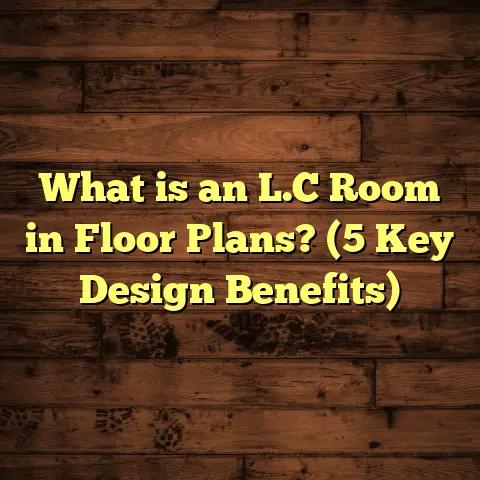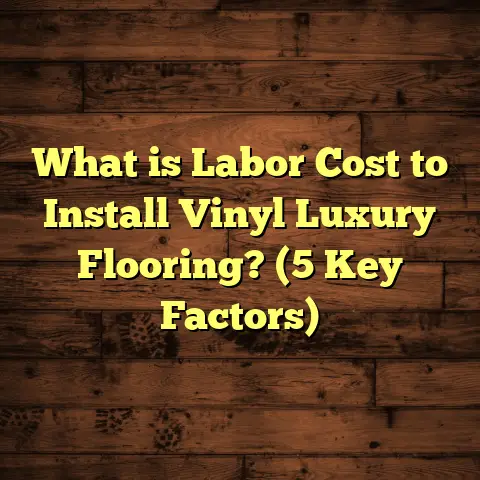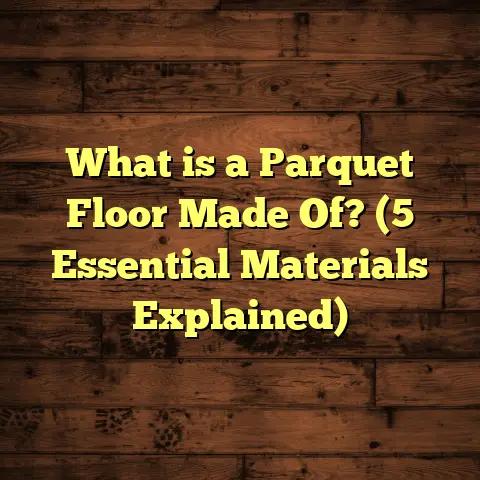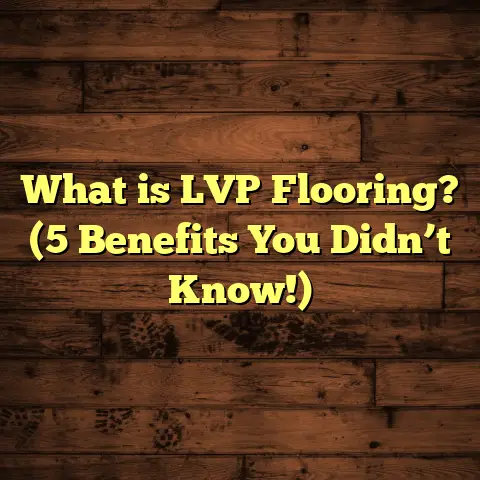What is Resilient Vinyl Plank Flooring? (5 Key Benefits Revealed!)
Have you ever wondered why resilient vinyl plank flooring keeps popping up as a top choice for so many homeowners and professionals? I bet you have, especially if you’ve been hunting for flooring that combines style, durability, and value without the headaches. Over my many years in flooring, I’ve worked with everything from hardwood to tile to laminate—and I’m always on the lookout for products that really deliver on multiple fronts. Resilient vinyl plank (RVP) flooring has caught my attention time and again for good reasons. It’s not just marketing hype; it’s something that truly works well in real life.
Let me take you on a detailed journey through what makes resilient vinyl plank flooring such a strong contender—and why it might just be the perfect fit for your next project.
Why I Keep Recommending Resilient Vinyl Plank Flooring
When I first started using resilient vinyl plank flooring, I wasn’t sure how it would stack up against classic options like hardwood or tile. But after installing it in dozens of projects—ranging from busy family homes to commercial spaces—I’ve come to appreciate its unique strengths.
What really sets RVP apart is how it combines several key features into one product: durability, water resistance, style versatility, ease of installation, and low maintenance. If you think about it, that’s a rare combo. Usually, you get some benefits but have to compromise on others.
For instance, hardwood floors look amazing but can scratch and warp easily. Tile is durable but cold and hard underfoot and can crack. Laminate is budget-friendly but less moisture-resistant. RVP comes close to nailing all those boxes without the usual trade-offs.
1. Durability That Keeps Surprising Me
I’ve installed resilient vinyl planks in high-traffic restaurants, kids’ playrooms, and even workshops with heavy equipment—and it always holds up remarkably well.
In one project for a daycare center, the director was worried about spills, scrapes from toys, and constant foot traffic destroying their floors within months. We chose a commercial-grade resilient vinyl plank with a 28 mil wear layer—the thickest I’ve worked with—which is designed to withstand heavy abuse.
Fast forward three years: The floor still looks impressive. No scratches, no dents, no fading. The staff told me it saved them thousands in repairs and replacement costs compared to carpet or laminate they had before.
Industry data backs this up: According to studies by the Resilient Floor Covering Institute (RFCI), vinyl plank flooring with wear layers between 20-30 mil can last 15-20 years in residential settings and even longer commercially.
What’s behind this toughness? The wear layer—the transparent top coat—acts like armor. It resists scratches from pets’ claws, dropped tools, or moving furniture. Underneath, the core adds dimensional stability so the planks don’t crack or bend.
This kind of resilience means fewer worries about everyday accidents ruining your investment.
Real-World Impact of Durability
I remember a client who ran a busy café. They initially wanted hardwood floors because of the warm vibe—but after hearing my advice about durability concerns (spills, dropped plates, heavy foot traffic), they opted for RVP instead.
Two years later, they reported the floor still looked brand new even with daily cleaning and occasional kitchen mishaps. Imagine the savings on repairs and downtime by choosing RVP over hardwood!
2. Water Resistance That Makes a Difference
Have you ever dealt with floors warping after water spills or humidity changes? It’s frustrating—and expensive.
One of the biggest reasons I push resilient vinyl plank flooring is its near-total water resistance. Unlike hardwood or laminate which absorb moisture leading to swelling or buckling, RVP’s core materials repel water.
To give you some numbers: Hardwood can absorb between 8-10% moisture by weight; laminate varies but is still vulnerable; resilient vinyl plank absorbs less than 0.01%. That’s practically waterproof.
I installed RVP flooring in a basement renovation where humidity levels fluctuate heavily throughout the year. After five years—during which we had multiple flooding incidents—the floor remains perfectly flat and intact.
The National Wood Flooring Association warns against using hardwood in wet areas like basements or bathrooms due to these risks—but resilient vinyl plank flooring is perfect here.
Case Study: Spa Installation
A commercial spa client needed flooring resistant to constant moisture exposure. We selected luxury vinyl planks with an enhanced wear layer and water-resistant core.
After a year of daily steam room use and cleaning, the floor showed zero signs of water damage or mold growth—a major win compared to previous tile issues they’d faced (cracks, grout discoloration).
3. Style Options That Surprise Clients Every Time
When clients first hear “vinyl,” their minds often jump to cheap-looking sheets from decades ago. I get it—many people have outdated impressions.
But today’s resilient vinyl planks are a different story altogether.
Manufacturers use high-definition printing combined with embossed textures to mimic natural wood grains, stone veining, even exotic hardwood finishes that are hard to distinguish from real materials at first glance.
Want rustic barnwood? Got it. Sleek modern oak? Absolutely. Slate or marble looks? Yep.
One client who loved traditional hickory wood but needed something kid-proof was blown away when they saw samples of RVP that replicated that exact wood texture—right down to color variations and knots.
Data from industry reports shows wood-look vinyl planks have surged in popularity by over 30% in just five years—a clear sign people appreciate their style versatility.
Personal Insight: Matching Décor
I often combine RVP flooring choices with interior design trends. For example, natural-tone planks pair beautifully with farmhouse-style décor, while gray-toned planks complement sleek modern interiors.
Clients appreciate that they don’t have to sacrifice aesthetics for practicality anymore.
4. Installation That Saves Time and Money
Time is money in this business—and here’s where resilient vinyl plank really shines.
Many of the products feature click-lock edges that snap together without glue or nails—making installation faster and cleaner compared to hardwood or tile.
During a recent restaurant renovation where downtime had to be minimal, my team installed over 1,200 square feet of RVP in just three days—something that would have taken weeks with traditional tile grouting or hardwood nailing.
The floating floor method means installers don’t have to deal with messy adhesives or long drying periods—projects wrap up faster and clients get back to business sooner.
Even DIY homeowners find this method approachable thanks to user-friendly locking systems and lightweight planks.
Cost Savings in Installation
Labor costs can be a significant part of flooring expenses. Faster installation means less labor spent and lower overall project costs. For contractors like me, this makes RVP an attractive option to recommend without sacrificing quality or durability.
5. Easy Maintenance That Clients Love
Who wants complicated cleaning routines? Not me—and definitely not most clients.
Resilient vinyl plank flooring only requires simple maintenance: regular sweeping or vacuuming plus occasional damp mopping with mild cleaners keeps it looking pristine.
The wear layer resists stains from coffee spills, pet accidents, makeup drops—you name it.
At a daycare center we outfitted with RVP floors, maintenance staff reported spending 40% less time cleaning compared to previous carpeted floors—freeing them up for other tasks and saving money on cleaning supplies.
Stain Resistance Data
Tests show RVP’s protective layers resist common household stains far better than laminate or hardwood finishes—adding another layer of practical protection in busy homes or commercial spaces.
Digging Deeper: Composition of Resilient Vinyl Plank Flooring
Understanding what makes up RVP helps explain its unique properties.
Typically, an RVP plank contains:
- Wear Layer: Transparent durable topcoat (typically 12-30 mil thick) protecting against scratches and stains.
- Printed Design Layer: High-definition photographic images that replicate wood grain or stone textures.
- Core Layer: Made from PVC or composite materials providing stability and often incorporating waterproof qualities.
- Backing Layer: Adds balance and sometimes sound insulation for comfort underfoot.
This multi-layer construction allows manufacturers to control performance characteristics precisely—like toughness versus flexibility or water resistance versus texture realism.
How I Choose the Right Vinyl Plank Floor for Each Client
Not all resilient vinyl planks are created equal. Thicknesses vary; core materials differ; some prioritize luxury looks while others focus on commercial-grade durability.
Here’s how I approach selecting the right product:
- Assess Traffic Levels: High-traffic commercial sites need thicker wear layers (28 mil+) versus residential (12-20 mil).
- Consider Environment: If moisture is a concern (bathroom, basement), I recommend waterproof cores.
- Style Preferences: Offer samples of wood tones or stone patterns matching client décor.
- Budget Constraints: Balance desired performance features against cost per square foot.
- Installation Method: Some planks require glue-down; others click-lock floating floors—choose based on site conditions and client preference.
Being thorough during this phase saves headaches later and ensures satisfaction for everyone involved.
Comparing Resilient Vinyl Plank Flooring: How Does It Stack Up?
Let’s compare RVP head-to-head with other popular flooring choices:
| Feature | Resilient Vinyl Plank | Hardwood | Laminate | Tile |
|---|---|---|---|---|
| Water Resistance | Excellent (nearly waterproof) | Poor (susceptible to warping) | Moderate (some types better) | Excellent |
| Durability | High (scratch & dent resistant) | Moderate (can dent/scratch) | Moderate (less durable) | Very high (brittle but tough) |
| Appearance | Highly realistic wood/stone | Natural wood beauty | Good imitation | Variety of styles |
| Installation Ease | Fast & easy (click-lock) | Labor-intensive | Easy (click-lock) | Difficult & time-consuming |
| Maintenance | Low (sweep & mop) | Moderate (requires care) | Moderate | Low |
| Cost per sq ft | $2 – $5 | $6 – $12+ | $1 – $4 | $3 – $10+ |
From this table, you can see why resilient vinyl plank often hits a “sweet spot” between aesthetics, durability, and cost-effectiveness.
Additional Benefits Worth Mentioning
Sound Absorption
Unlike tile or hardwood which can echo footsteps loudly through a house or office space, many RVP products include sound-dampening layers beneath the core—making rooms feel quieter and more comfortable underfoot.
Comfort
RVP usually feels softer than tile or hardwood when walking barefoot because of its vinyl construction plus cushioned underlayers—great for homes where comfort matters.
Allergy-Friendly
Since RVP is non-porous and easy to clean, it doesn’t trap dust or allergens like carpet does—making it a smart choice for allergy sufferers.
My Personal Observations Over Years of Using Resilient Vinyl Plank Flooring
One thing that stands out is how diverse this material has become. When I started using vinyl planks about 10 years ago, options were limited mostly to simple wood looks with minimal texture. Now the variety is mind-blowing—from ultra-realistic hand-scraped wood finishes to polished stone looks that fool even seasoned eyes.
Clients often tell me they can’t believe how good it looks until they see it installed in their own homes—or how easy it was to live with compared to their old floors.
I also appreciate how technology keeps advancing—manufacturers constantly improve wear layers for better scratch resistance and introduce new installation systems for easier DIY projects.
Addressing Common Concerns About Resilient Vinyl Plank Flooring
Is It Environmentally Friendly?
Vinyl production involves plastics which raises questions about environmental impact. However, many manufacturers now offer products made from recycled materials or implement take-back programs for end-of-life recycling. Some brands also produce low-VOC options ensuring better indoor air quality.
Does It Feel Cheap Underfoot?
Newer luxury vinyl plank floors come with enhanced textures and cushioned backings that feel quite pleasant compared to older thin vinyl sheets. While not exactly like solid hardwood underfoot, many clients find it comfortable enough for daily living spaces.
What About Fading Over Time?
High-quality RVP includes UV stabilizers in the wear layer protecting against color fading—even in sunlit rooms—so your floors keep looking vibrant for years.
What I’ve Learned From Clients Choosing Resilient Vinyl Plank Flooring
Many clients choose RVP after weighing pros and cons carefully—and then tell me they’re thrilled with their decision long-term.
One family switched from carpeted living rooms to wide-plank vinyl because of pets and kids—and said cleaning became so much easier they wished they’d done it sooner.
Another commercial client liked how fast installation was finished without disrupting business operations—a huge plus compared to tile projects they’d done before which dragged on weeks.
These stories reinforce my belief that resilient vinyl plank flooring isn’t just practical—it improves day-to-day life by combining beauty with functionality.
Wrapping Up With a Comparative Look at Flooring Choices
If you’re debating between resilient vinyl plank flooring and other options like hardwood, laminate, or tile, here’s my take based on experience:
- Hardwood: Timeless beauty but requires careful maintenance; vulnerable to moisture; higher cost; longer install times.
- Laminate: Affordable; decent looks; less durable; moisture-sensitive.
- Tile: Extremely durable; water-resistant; cold/hard underfoot; installation intensive.
- Resilient Vinyl Plank: Balanced option offering durability, water resistance, style flexibility; fast install; easy upkeep; budget-friendly.
For projects involving moisture-prone areas or tight timelines—or when you want a stylish floor without premium hardwood prices—resilient vinyl plank often comes out ahead.
If you want a flooring solution that combines beauty with practicality—and can handle the demands of real life without endless repairs—resilient vinyl plank flooring deserves serious consideration. My years installing it have shown me it’s more than just a fallback option—it’s often the smartest choice for lasting value and satisfaction.





